
The roe deer, also known as the roe, western roe deer, or European roe, is a species of deer. The male of the species is sometimes referred to as a roebuck. The roe is a small deer, reddish and grey-brown, and well-adapted to cold environments. The species is widespread in Europe, from the Mediterranean to Scandinavia, from Scotland to the Caucasus, and east as far as northern Iran.

The sika deer, also known as the Northernspotted deer or the Japanese deer, is a species of deer native to much of East Asia and introduced to other parts of the world. Previously found from northern Vietnam in the south to the Russian Far East in the north, it is an uncommon species that has been extirpated in most areas of its native range, except in Japan, where it is overabundant and present in very large numbers.
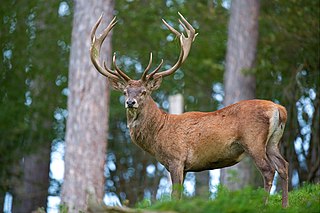
The red deer is one of the largest deer species. A male red deer is called a stag or hart, and a female is called a hind. The red deer inhabits most of Europe, the Caucasus Mountains region, Anatolia, Iran, and parts of western Asia. It also inhabits the Atlas Mountains of Northern Africa; being the only living species of deer to inhabit Africa. Red deer have been introduced to other areas, including Australia, New Zealand, the United States, Canada, Peru, Uruguay, Chile and Argentina. In many parts of the world, the meat (venison) from red deer is used as a food source.
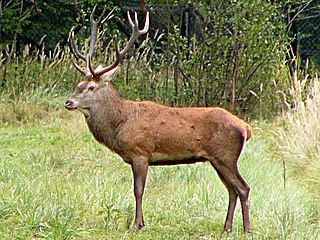
Cervus is a genus of deer that primarily are native to Eurasia, although one species occurs in northern Africa and another in North America. In addition to the species presently placed in this genus, it has included a whole range of other species now commonly placed in other genera. Additionally, the species-level taxonomy is in a state of flux.
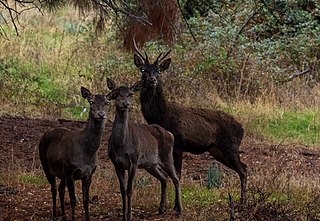
The Barbary stag, also known as the Atlas deer or African elk, is a subspecies of the red deer that is native to North Africa. It is the only deer known to be native to Africa, aside from Megaceroides algericus, which went extinct approximately 6,000 years ago.
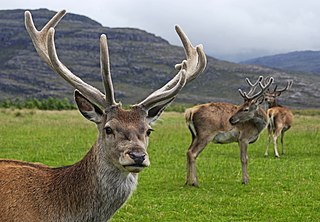
The Scottish red deer is a subspecies of red deer, which is native to Great Britain. Like the red deer of Ireland, it migrated from continental Europe sometime in the Stone Age. The Scottish red deer is farmed for meat, antlers and hides.

The Caspian red deer, is one of the easternmost subspecies of red deer that is native to areas between the Black Sea and Caspian Sea such as Crimea, Asia Minor, the Caucasus Mountains region bordering Europe and Asia, and along the Caspian Sea region in Iran. The Caspian red deer is sometimes referred to as maral, noble deer, or eastern red deer.

The Kashmir stag, also called hangul, is a subspecies of Central Asian red deer endemic to Kashmir and surrounding areas. It is found in dense riverine forests in the valleys and mountains of Jammu and Kashmir and northern Himachal Pradesh. In Kashmir, it is found primarily in the Dachigam National Park and in Tral Wildlife Sanctuary where it receives protection, and elsewhere it is more at risk. In the 1941s, the population was between 3000 and 5000 individuals, but since then habitat destruction, over-grazing by domestic livestock and poaching have reduced population dramatically. Its population is now grown marginally to 289 in 2023 from 197 in 2004. It is the state animal of Jammu and Kashmir. It is the only surviving Asiatic sub-species of the Red deer family.

The Manchurian wapiti is a subspecies of the wapiti native to East Asia.
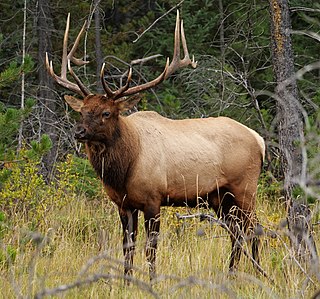
The elk, or wapiti, is the second largest species within the deer family, Cervidae, and one of the largest terrestrial mammals in its native range of North America and Central and East Asia. The word "elk" originally referred to the European variety of the moose, Alces alces, but was transferred to Cervus canadensis by North American colonists. The name "wapiti" derives from a Shawnee and Cree word meaning "white rump" for the distinctive light fur in the rear region, just like the Bighorn Sheep.

The Central Asian red deer, also known as the Tarim red deer is a deer species native to Central Asia, where it used to be widely distributed, but is scattered today with small population units in several countries. It has been listed as Least Concern on the IUCN Red List since 2017. It was first described in the mid-19th century.
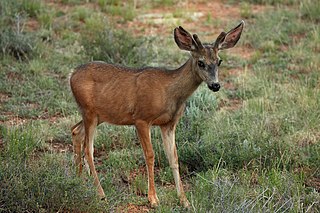
The Capreolinae, Odocoileinae, or the New World deer are a subfamily of deer. Alternatively, they are known as the telemetacarpal deer, due to their bone structure being different from the plesiometacarpal deer subfamily Cervinae. The telemetacarpal deer maintain their distal lateral metacarpals, while the plesiometacarpal deer maintain only their proximal lateral metacarpals. The Capreolinae are believed to have originated in the Middle Miocene, between 7.7 and 11.5 million years ago, in Central Asia.

The Altai wapiti, sometimes called the Altai elk, is a subspecies of Cervus canadensis found in the forest hills of southern Siberia, northwestern Mongolia, and northern Xinjiang province of China. It is different from the Tian Shan wapiti in being smaller and paler in color.
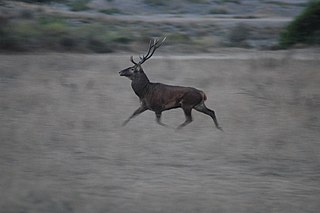
The Corsican red deer, also known simply as the Corsican deer or Sardinian deer, is a subspecies of red deer found on the Mediterranean islands of Sardinia (Italy) and Corsica (France).
The Alashan wapiti is an Asian subspecies of wapiti, or elk as they are called in North America.
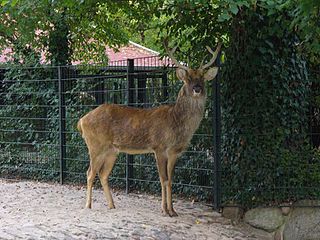
Rucervus is a genus of deer from India, Nepal, Indochina, and the Chinese island of Hainan. The only extant representatives, the barasingha or swamp deer and Eld's deer, are threatened by habitat loss and hunting; another species, Schomburgk’s deer, went extinct in 1938. Deer species found within the genus Rucervus are characterized by a specific antler structure, where the basal ramification is often supplemented with an additional small prong, and the middle tine is never present. The crown tines are inserted on the posterior side of the beam and may be bifurcated or fused into a small palmation.

Cervus elaphus acoronatus is an extinct subspecies of the red deer belonging to the family Cervidae. Some authors consider it a distinct species, Cervus acoronatus.

Praemegaceros is an extinct genus of deer, known from the Pleistocene and Holocene of Western Eurasia. It contains the subgenera Praemegaceros,Orthogonoceros and Nesoleipoceros. It has sometimes been synonymised with Megaloceros and Megaceroides, however they have been found to be generically distinct.

Megaceroides algericus is an extinct species of deer known from the Late Pleistocene to the Holocene of North Africa. It is one of only two species of deer known to have been native to the African continent, alongside the Barbary stag, a subspecies of red deer. It is considered to be closely related to the giant deer species of Eurasia.



















